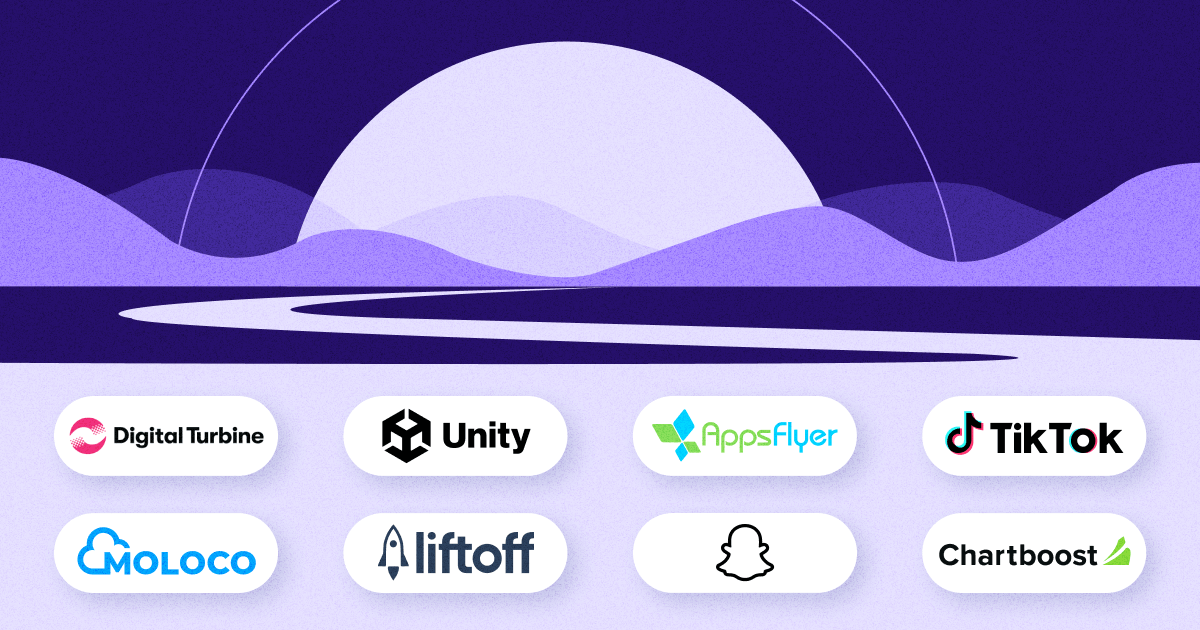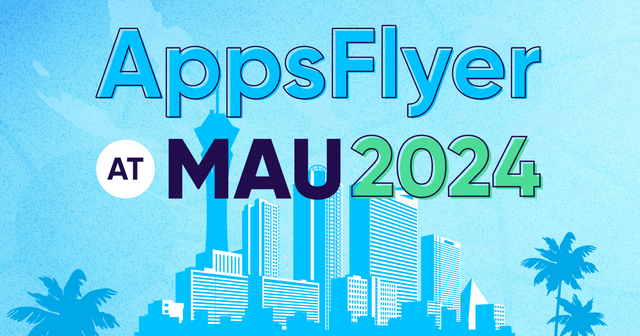
The power of storytelling in mobile marketing: why it should be a priority for brands in Africa

Introduction
Checking our phones is one of the first five activities we are likely to do when we wake in the morning, and more than 70% of us spend at least 3 hours talking, messaging, streaming, working, living and playing on our phones every single day.
Our phone habits say a lot about us – namely, how hungry we are for content. Whether it’s gossipping with a friend via WhatsApp, catching up on the latest blockbuster movie trailer on YouTube, or following along with breaking news on Twitter, our phones have become dedicated to content sharing and consumption.
At the heart of most kinds of content lies a story. It is this story – and the telling of it – that marketers and brands need to focus on if they want to have success in 2021 and beyond.
As a marketer, getting your audience’s time and attention isn’t something that can be forced – it has to be earned. This is where storytelling and marketing go hand-in-hand, to create a compelling narrative that captures your audience’s interest.
What is it that makes storytelling such a powerful tool for marketers today? Simply put, effective storytelling makes the audience feel something. It establishes an emotional connection between brand and audience. It can inspire, humanise, and help people relate to what it is that you do – and why your company is so great at it.
The pandemic has accelerated the need for storytelling in marketing
This appetite for storytelling has opened the door for brands to increase their focus on non-traditional advertising platforms. People want to listen to individuals, personalities, real-life testimonies and stories. Marketing may have pivoted to video in the middle of the last decade, and storytelling on platforms like Instagram and TikTok represent the next step on that road.
The Covid-19 pandemic has had an impact on this, too. As society reduced social contact and face-to-face interaction to prevent the spread of the virus, our desire for – and familiarity with – digital communication took off like never before. People who had never even heard of Zoom were now using it to chat to their grandparents and have virtual social evenings with their friends.
In the 12 months or so that’s followed, we’ve become more and more familiar with digital storytelling – and brands have followed suit. After all, storytelling is an incredibly effective way to show people how a brand will benefit them. It takes its power from showing, rather than telling. It is far easier to draw in your audience with a story in comparison to directly “commanding” them to buy whatever it is you’re selling.
Every business should be focussed on building strong relationships with their customers, and storytelling works as a natural extension of a people-centric approach. It allows you to show audiences how they benefit from your brand, in a way that creates a strong emotional bond.
Storytelling drives 3x increase in engagement for Wema Bank
Should you still need convincing about the value of storytelling in marketing, here’s an example from a campaign we at Wema Bank ran in 2019. Working closely with the Nigerian singer Teniola Apata (better known as Teni), who is one of our Brand Ambassadors, we created the #SaveLikeTeni campaign to promote a savings culture among young Nigerians. The campaign also demonstrated the benefits of saving with the fully-digital bank, ALAT, using a Goal savings account.
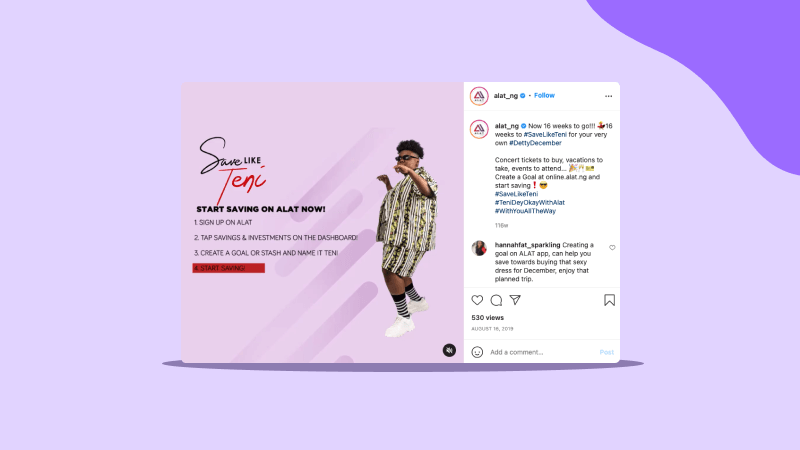
#SaveLikeTeni was a huge success. People became avid followers of Teni’s story of her own saving efforts, with #SaveLikeTeni content garnered over 8 million impressions in the first 4 weeks of the campaign – almost an 8x increase.
The primary goal of the campaign – driving the creation of new savings accounts – was also met. In the first month after #SaveLikeTeni went live, and we saw a 66% rise in new savings accounts. By the end of the campaign, we were seeing more than double the amount of new accounts created every month than before launch.
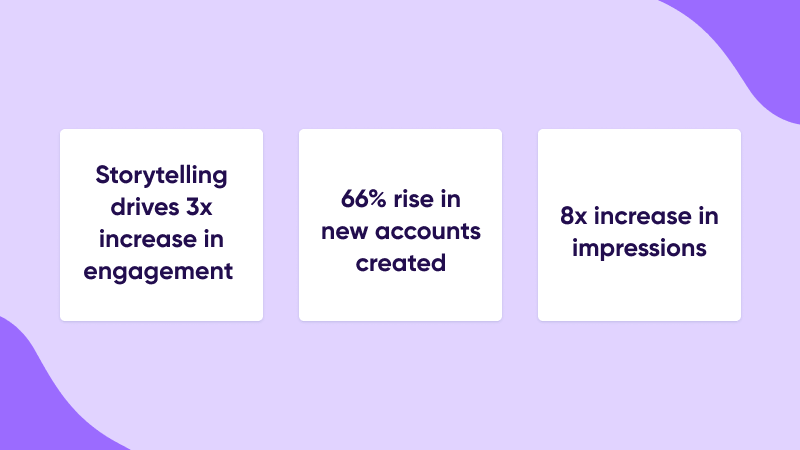
So why was #SaveLikeTeni successful? Because it told a compelling, relatable story. Teni’s own career as a musician is rooted in hard work and resiliency, making her perfectly suited to an inspiring story of growing one’s savings from small beginnings. By having Teni give the audience a glimpse into her own personal life and goals, we were able to provide an inspiring message to which any of our audience could relate.
Making storytelling work for your own brand marketing
As a marketer, you are constantly asking yourself “what works best for me and my team?” Storytelling is no different. Wema Bank is the oldest indigenous bank in Nigeria, so we felt instinctively that we had a heritage, a history, and a lot to say. We’ve reinvented the way that our customers can access and manage their finances through a greater digital offering – and that provides the starting point for all kinds of story-led interactions with our audiences.
We also shifted our strategy post-pandemic to capitalise on the increased adoption of video communication platforms. From the second half of 2020 onwards, we reduced our focus on traditional advertising platforms and turned our attention towards more personality-led video instead.
Ultimately, it’s important to keep on top of what it is that you’re trying to say. We recently celebrated our 76th anniversary, and wanted a way to further develop our customers’ trust in our services. To achieve this, we linked up with a long-time customer of Wema Bank, who spoke about how our community banking helped him to save money to fund his university education in the 1960s.
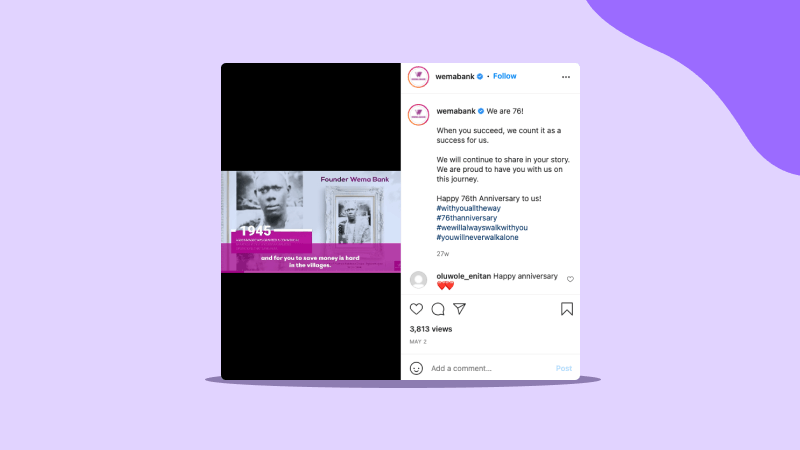
One thing we’ve learned from our storytelling marketing efforts (like #SaveLikeTeni) is that audiences want to listen to individuals. Personalities resonate much more strongly than “corporate” entities: it’s far easier for an audience to empathise with a real person over a business. Our 76th anniversary post, above, garnered over 3,000 engagements on the Wema Bank Instagram, a 10-fold increase over our average daily engagement.
Listen to your audience’s own stories
Don’t overlook the fact that storytelling works both ways. Your customers will be telling you their own stories – hopefully, positive ones! As marketers, we should constantly be on the lookout for inspiring examples and moments from the very people we’re directing our marketing towards.
This is another area where the #SaveLikeTeni campaign was so successful. In response to Teni’s own efforts to save, our customers were quick to share their own tales on social media: what they were saving for, how they were progressing, what steps they had taken to grow their savings even just a small amount.
Leveraging those stories and amplifying them back to your audience has to be your priority. It creates an inspiring feedback loop where customers see real, authentic voices discussing their positive experiences with your brand. For example, we ran a promotion to become a millionaire and filmed testimonials with winning customers to not only boost trust but create more widespread appeal of the promo. The impact was immediate, with not only more entrants going forwards but also an increase in transactions.
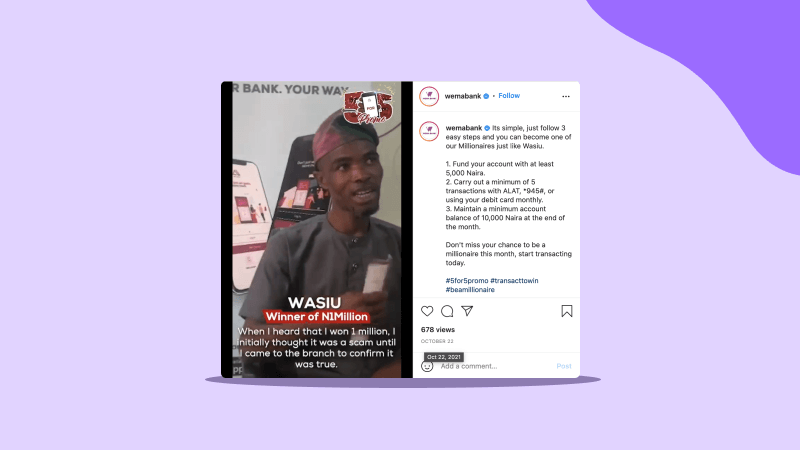
To return once more to our #SaveLikeTeni example, the way we positioned this campaign was vital in its success. As mentioned above, one of the central tenets of this campaign was to promote a savings culture among our audience. But saving money shouldn’t just be about watching a number tick upwards.
We challenged our audience to frame their saving efforts with a purpose: what are they saving towards (eg, new shoes, a new phone, a holiday, a relative’s birthday present)? What lifestyle changes do they need to make to reach that goal? How long might it take, and how are they progressing week by week, month by month? Each little detail adds a layer of humanising, empathetic richness to the story.
Key takeaways
- Storytelling in marketing helps brands rise above traditional advertising. In a world with increasingly shortened attention spans, mobile marketing campaigns need to catch the eye – and sustain interest – or just get scrolled past without a second glance.
- Telling a story with your marketing feels personal, and bespoke. It directly addresses your customers in a relatable and emotional way. Your marketing efforts should also:
- Put the individual over the collective: audiences will find it far more compelling to hear from a personality (either a known brand ambassador or another customer – “one of them”) than a company entity.
- Listen to the stories your own customers – existing and potential – are telling you about your own product and service. Address the pain points and amplify the positive ones.
- Capitalize on the increased familiarity with video communication technology to pivot away from traditional advertising outlets into emerging, story-led platforms.
- Compelling stories will always resonate with your audience. It’s over to us as marketers to find the best way to leverage our own brand’s story, and show – not tell – our customers our true value to them.




